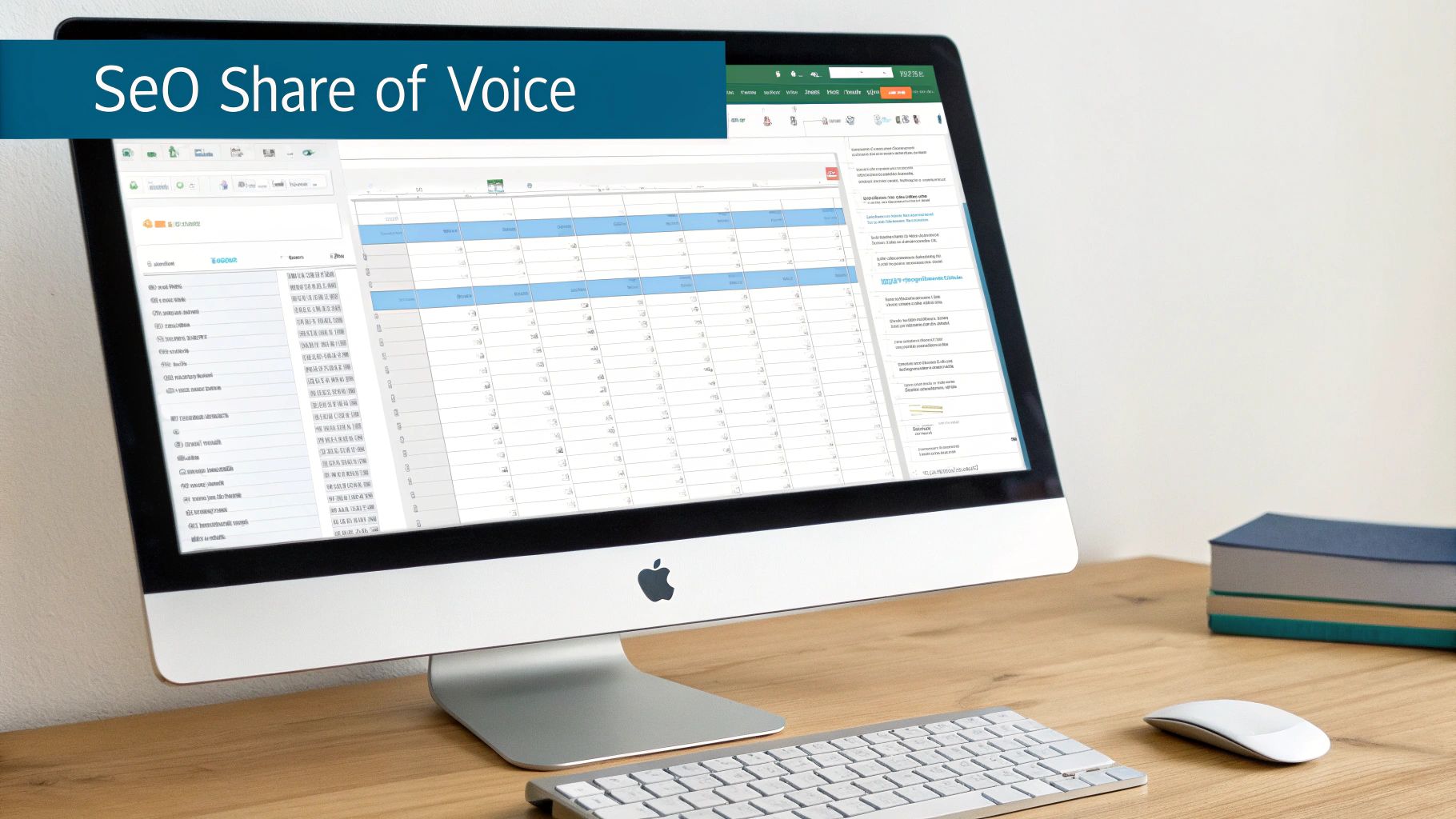
Let’s cut the fluff. Share of Voice (SOV) is your brand’s slice of the conversation pie. At BillyBuzz, we treat it as our single most important growth metric. Why? Because market share tells you what already happened, but SOV predicts what’s coming next. It’s our crystal ball for tracking future wins in the battle for customer attention.
Why SOV Is Your Most Important Growth Metric
It's easy to get lost in vanity metrics like follower counts. We don't. Share of Voice is pure business intelligence—a direct reflection of your visibility compared to everyone else chasing the same audience.
A rising SOV is the most reliable leading indicator of market share growth. It's that simple.

This isn't theory for us; it’s our operational framework. A sudden jump or dip in our SOV triggers immediate action, from content pivots to product launch timing. We watch that number relentlessly.
The Core Share of Voice Calculation
The basic formula is refreshingly simple. The classic share of voice calculation is your brand's total mentions divided by the total mentions for your entire industry (you plus your competitors), then multiplied by 100 for a percentage.
If your brand gets 100 mentions and the total industry conversation is 1,000 mentions, your SOV is 10%. You can learn more about how to measure share of voice on different channels to see how this applies from paid ads to organic search.
As a founder, you have to choose your metrics carefully. SOV is our North Star because it tells us if our message is breaking through the noise. If that number isn't growing, nothing else matters.
This approach gives you a clear, honest benchmark of your authority in the market.
SOV Predicts the Future; Market Share Lags Behind
Thinking about SOV versus market share is critical for any team serious about growth. Market share is a lagging indicator—it measures past sales and tells you where you’ve been. SOV is a leading indicator, giving you a powerful signal of where you’re going.
Here’s a quick breakdown of how these two metrics tell different parts of your brand's story.
Share of Voice vs Market Share: A Strategic Comparison
| Metric | What It Measures | Timing | Strategic Value |
|---|---|---|---|
| Share of Voice | Your brand's share of the total conversation (mentions, traffic, impressions) within your industry. | Leading Indicator | Predicts future growth. Helps you proactively adjust marketing and messaging to capture attention before sales happen. |
| Market Share | Your brand's percentage of total sales within your industry. | Lagging Indicator | Reports on past performance. It's a look in the rearview mirror, telling you what has already been achieved. |
A brand with a higher share of voice than its share of market is almost always poised for growth. This is exactly why we focus on dominating conversations in key communities.
We know winning the conversation today translates directly into winning customers tomorrow. This proactive stance is far more powerful than reacting to last quarter's sales figures.
How to Identify Your True Competitors
Your share of voice calculation is only as accurate as your competitor list. I’ve seen so many founders either track only the obvious giants (making their SOV look impossibly small) or track dozens of irrelevant players, creating a noisy, useless dataset.
Getting this foundation right is non-negotiable.
You need a complete map of who is capturing your audience's attention. This means your list has to be broader than you might think.
Mapping Your Competitive Landscape
The best way to do this is to categorize competitors into three tiers. This framework keeps us from getting distracted by irrelevant noise and helps us put resources where they’ll have the most impact.
Here’s the breakdown we use:
Direct Competitors: Brands offering a similar solution to the same audience. For us, it’s other social monitoring tools built for startups. They're the most obvious, but they're rarely the only ones to watch.
Indirect Competitors: Businesses solving the same core problem with a different solution. Think of a marketing agency—they also help founders get customers, just not with a SaaS tool. They compete for the same budget and attention.
Aspirational & Influencer Competitors: These aren't businesses. They are the ones who dominate the conversation your customers are in. This could be a top-tier industry publication, an influencer, or a blog that owns the keywords you’re trying to rank for. Ignoring them means you're missing a massive piece of the puzzle.
We once noticed a single marketing influencer had a higher share of voice on "customer acquisition for startups" than our top three direct competitors combined. That insight completely shifted our content strategy.
Building Your Competitor Tiers
Start by brainstorming every player in each category. Use SEO tools to see who’s ranking for your target keywords or who gets mentioned alongside your brand. To really dig in, using a competitive analysis template can be a game-changer.
Once you have a solid list, organize everyone into those three tiers.
Your direct competitors are your highest priority—track them daily or weekly. For indirect and aspirational competitors, monitoring them monthly is usually enough to spot broader trends.
This tiered approach is the secret to a meaningful share of voice calculation. For a deeper dive, check out our guide on competitor analysis for emerging businesses. It gives you a complete framework for building an actionable list.
How We Actually Track Brand Mentions (Our Toolkit)
Theory is great, but execution is what counts. Here's the exact, no-fluff workflow we use at BillyBuzz to track mentions. Forget expensive suites; we use a scrappy, layered approach that gets the job done.
It all starts with organizing our competitors into tiers. This is the foundation of our entire process.

This tiered system is a game-changer. It helps us focus intense monitoring on direct competitors while keeping a pulse on the wider market conversation.
The Core Monitoring Stack
For automated social and web monitoring, we use Brand24 and Talkwalker. The secret isn't the tools, but how you set them up. Proper configuration is the difference between clean data and useless noise.
We get incredibly granular with our alert rules in Brand24. Here’s a peek at what that looks like for us:
- Required Keywords:
"BillyBuzz","billybuzz.com", and common misspellings like"Billy Buzz". - Contextual Keywords (at least one must be present):
"recommend","alternative to","vs","review","pricing","how to". - Negative Keywords (must NOT be present):
-jobs,-careers,-hiring,-login,-issue,-"our team". This filters out job postings and support tickets from muddying our data.
Digging into Niche Communities
The most valuable conversations happen in forums. For this, we use F5Bot to monitor Reddit. It’s a simple tool that works wonders.
Our rule is simple: if a subreddit has >50,000 members and discusses customer acquisition or SaaS, we track it. We don't just track our brand; we track competitor names and problem-based keywords.
A few subreddits constantly on our radar include:
r/saasr/startupsr/marketingr/smallbusiness
To round things out, we use Google Alerts as our free safety net. It’s not sophisticated, but it catches mentions on smaller blogs that bigger platforms miss. It's a low-effort, high-reward part of our stack.
If you're looking to get more advanced, getting familiar with Natural Language Processing (NLP) can unlock deeper insights. You can also see how technology is pushing this forward by checking out our guide to the top AI tools for social listening in 2024.
This combined toolkit feeds us the raw data for an accurate share of voice.
How to Calculate Your SEO Share of Voice for High-Intent Keywords
Social chatter is nice, but owning search intent pays the bills. While social SOV gives you a pulse on the conversation, SEO Share of Voice shows you how visible you are for keywords people type when they're ready to buy. This is how we track if our content is actually driving organic growth.

This is about cutting through the noise. We don't chase vanity metrics. We zero in on a curated set of 50-100 high-intent keywords. These aren't just high-volume terms; they're the long-tail, problem-aware phrases that signal someone is close to a decision.
The Ahrefs Workflow We Use
We use Ahrefs for this. Specifically, its Rank Tracker feature, to monitor performance against our top five competitors for that core keyword set. The metric that matters most here is impressions, as it tells us how often our pages show up in search results.
Here’s the simple, repeatable workflow we run monthly:
- Lock in the Keyword Set: We start with our list of 50-100 high-intent keywords in a spreadsheet. This is our source of truth.
- Export the Competitor Data: In our Ahrefs project, we go to Rank Tracker and pull the "Competitors" report. We export the traffic share data for our site and competitors.
- Find the Total Market Impressions: The export gives us the estimated traffic and visibility. We sum the impression data for our brand and all competitors to get the total market size.
- Do the Final Calculation: Once you have that total, the share of voice calculation is:
(Your Brand's Impressions / Total Market Impressions) * 100.
We learned the hard way that tracking thousands of keywords is a waste of time. A focused, high-intent list gives a much cleaner signal on whether we're winning the visibility battle that leads to customers.
Let's look at a quick example. A SaaS company tracks 50 crucial keywords. From that set, they get 15,000 search impressions per month. If the total potential impressions across all competitors add up to 100,000, their SEO SOV is 15%.
This means their content shows up in 15% of all possible searches for their most important keywords.
This simple percentage tells us exactly where we stand. It’s a direct measure of our organic real estate and a critical KPI for our content team. Of course, remember that visibility is also shaped by what happens off-page; our guide on social signals and link building dives deeper into that relationship. By keeping our focus on high-intent keywords, we make sure our efforts are always tied to potential revenue.
Turning Your SOV Data Into Actionable Strategy
A share of voice calculation is just a number until you do something with it. At BillyBuzz, we treat SOV reports as triggers for action. Data without a clear response is noise.
When a competitor’s SOV spikes, we immediately dig in. Was it a PR launch? A viral article? A new ad campaign? Understanding the "why" is the only way to respond intelligently.
If our own SOV is flat, it kicks off an internal review. A stagnant number is a signal that our message isn't breaking through, and it's time to try something new.
From Observation to Action
We've developed simple response templates for engaging with mentions, especially on platforms like Reddit. We don’t guess; we diagnose and then act.
We once saw a competitor gain huge traction in
r/productmanagement, a subreddit we weren't watching. Our SOV numbers flagged their spike. That single data point pushed us to create targeted content for that community, and within a month, we’d reclaimed a big piece of that conversation.
The real power of a consistent share of voice calculation is that it points you to opportunities and threats you would have otherwise missed.
Here's a look at our internal framework for turning raw SOV data into concrete actions.
Our SOV Data to Action Framework
| SOV Observation | Potential Cause | Our Action Item |
|---|---|---|
| Our SOV is flat. | Our content has become stale or isn't resonating. | We re-evaluate our content calendar and test a new format (e.g., a data-driven report instead of a standard blog post). |
| A direct competitor's SOV spikes. | They launched a new feature, secured press, or started a new ad campaign. | Our team investigates the source. We then decide whether to counter-program with our own announcement or cede the short-term conversation. |
| An indirect competitor is gaining traction. | They are successfully reframing the customer's problem. | We analyze their messaging to see what we can learn. This often leads to refining our own sales copy and marketing materials. |
| We find an unprompted positive mention. | Someone recommends our product in a relevant community. | We use a "helpful expert" template: "Glad to hear BillyBuzz is working for you! For anyone else interested, the [feature name] is particularly useful for [use case]. Happy to answer any questions." |
This isn't just about reacting; it's about staying agile and informed by what's actually happening in the market.
Think about the sports apparel world, where Nike commands 94.4% SOV compared to Reebok's 5.6%. For Reebok, this data gives them a brutally clear picture. It helps them avoid going head-to-head where they can't win and instead find niche conversations they can own. Brand24 breaks down this competitive dynamic, and it’s a perfect example of how SOV data paints the strategic picture.
Common Questions About Share of Voice
Here are the most common questions we get from other founders. Direct, no-fluff answers based on what we've learned in the trenches.
How Often Should I Calculate Share of Voice?
Run a full share of voice calculation monthly or, at minimum, quarterly. This gives you enough data to see real trends.
But that doesn't mean we ignore it the rest of the time. We watch our mention alerts daily.
If there's a sudden spike in conversation—ours or a competitor's—we jump on it immediately. Think of it as a quarterly strategic review with daily tactical check-ins.
Should My Own Brand Posts Be Included?
Absolutely not. This is the single most common mistake. Share of Voice measures the organic conversation about your brand, not the content you’re pushing out.
Including your own posts is a classic vanity metric trap. It inflates your numbers and gives you a false sense of security. SOV is a measure of earned media, not owned media.
The point is to understand how your brand is resonating. Keeping your own posts out of the equation ensures your share of voice calculation is an honest reflection of your brand's impact.
What Is a Good Share of Voice Percentage?
It completely depends on your industry. In a crowded market, grabbing 10% can be a massive win. In a newer niche, you should aim to dominate with 40% or more.
The real goal isn't a magic number. It's about consistent, quarter-over-quarter growth. Your most important benchmark is your own past performance. The question is: are we gaining ground?
How Does Sentiment Fit into the Calculation?
Sentiment is a second layer of analysis. The first, critical step is to measure the raw volume of mentions. Get that locked in first.
Once you have that baseline, then dig into sentiment. A high SOV driven by negative press is a crisis, not a victory. At BillyBuzz, we track our "net sentiment score" as a separate KPI right alongside our main SOV. This gives us the full picture—not just the quantity of the conversation, but the quality, too.
Ready to stop guessing and start winning the conversation on Reddit? BillyBuzz uses AI to find you qualified leads and high-intent conversations, so you can engage customers at the perfect moment. Discover how BillyBuzz can automate your growth.
